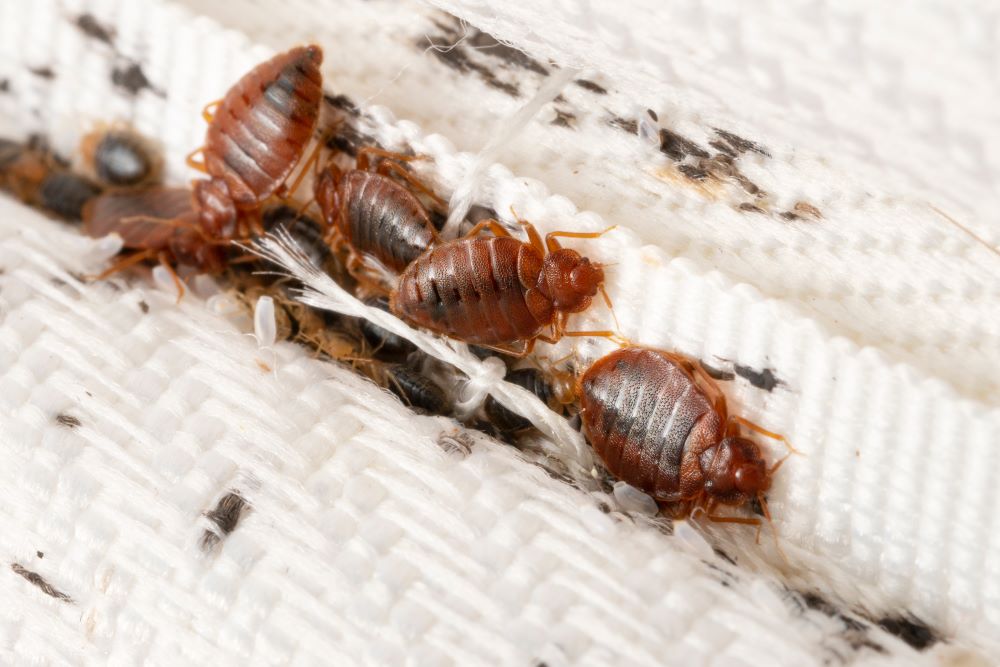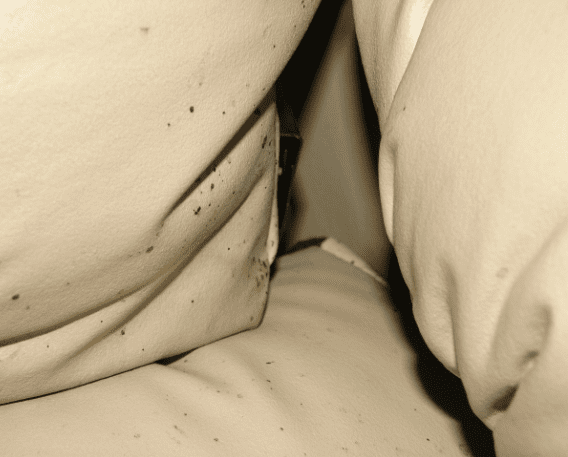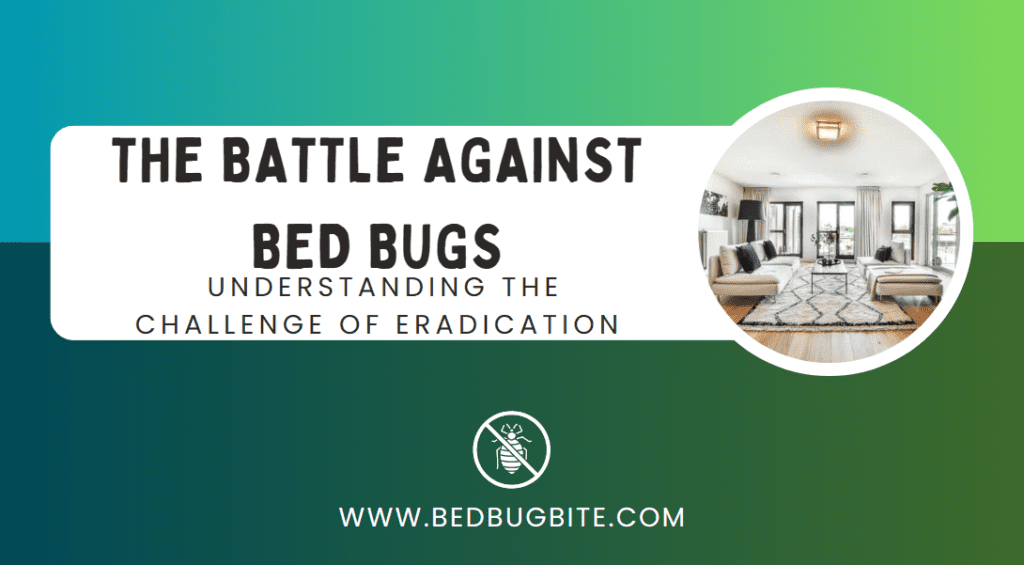Understanding the Tenacity of Bed Bugs
The Battle Against Bed Bugs. Bed bugs, those tiny, elusive pests, have long been a source of distress in homes and hotels worldwide. Understanding their tenacity is critical in the fight against them. These pests, known scientifically as Cimex lectularius, thrive in close proximity to humans, their preferred hosts. Despite their small size, bed bugs pose a significant challenge due to their resilience and adaptability. …Click Here to Read More Bed Bug Facts!
The rising concern over bed bug infestations isn’t unfounded. Recently, there’s been a resurgence, primarily attributed to increased travel and resistance to common pesticides. Bed bugs are master hitchhikers, making their way into our homes through luggage, furniture, and even clothing. Once settled, they reproduce rapidly, turning a small problem into an infestation quickly.
The Challenge of Eradicating Bed Bugs
But what makes bed bugs particularly challenging to eradicate? It boils down to their biological and behavioral traits. These nocturnal creatures are experts at hiding, often going unnoticed until their numbers swell. They can survive for months without feeding, waiting out many control attempts. Additionally, their ability to develop resistance to pesticides has rendered some traditional methods less effective.

As we delve deeper into this topic, it’s important to recognize that tackling a bed bug infestation requires more than just a one-off effort; it demands a comprehensive understanding and strategic approach. This is where our journey into the world of bed bugs begins, unraveling the intricacies behind their survival and exploring effective ways to manage and prevent infestations.
For those keen on understanding the science behind these pests, the Entomological Society of America provides valuable insights into bed bug biology and behavior, offering a solid foundation for our discussion. Explore their research here.
In the following sections, we’ll uncover the lifecycle of bed bugs, the dynamics of infestation, and the common pitfalls in their eradication. Our goal is to arm you with the knowledge and tools to effectively combat these resilient pests, ensuring your home remains a bed bug-free zone.
The Biology of Bed Bugs: Unraveling the Mystery
The battle against bed bugs begins with understanding their biology. These tiny creatures, often invisible to the naked eye, possess unique traits that contribute to their survival and proliferation in human environments.
Bed Bug Lifecycle: Key to Their Survival
The lifecycle of a bed bug is a fascinating yet alarming process. It starts as an egg, barely visible to the human eye, and progresses through several nymph stages before reaching adulthood. This development, under favorable conditions, can happen in as little as a month, and females lay hundreds of eggs in their lifetime. This rapid reproduction rate is a primary reason why small infestations can quickly become overwhelming. The Battle Against Bed Bugs
Adaptations: How Bed Bugs Evade Common Control Methods
Bed bugs have developed remarkable adaptations that make them formidable pests. Their flattened bodies allow them to hide in minuscule crevices, evading detection and most eradication efforts. Moreover, they have evolved resistance to several chemical pesticides, a defense mechanism that challenges even the most seasoned exterminators. This resistance is not just a local phenomenon but a global issue, as highlighted in studies like those from the Journal of Economic Entomology, detailing the genetic factors behind this resistance [Read more about their research](https://academic.oup.com/jee).
Feeding Habits: Understanding Their Reliance on Human Hosts
The feeding habits of bed bugs are intricately linked to their survival. These nocturnal pests feed exclusively on blood, preferably human, emerging from their hiding spots at night. Their bites are initially painless, allowing them to feed undetected. However, the aftermath of their feeding can cause discomfort and allergic reactions in humans. Understanding their feeding patterns is crucial in identifying their presence and implementing timely control measures.
In conclusion, the biology of bed bugs, from their rapid life cycle and unique adaptations to their specialized feeding habits, plays a crucial role in their persistence in human habitats. Acknowledging and understanding these aspects are the first steps in devising effective strategies to combat these pests. As we delve deeper into the dynamics of infestations and common eradication mistakes, it becomes clear that controlling bed bugs requires more than just basic knowledge; it requires a thorough understanding of their biology and behavior.
The Infestation Dynamics: More Than Meets the Eye
Understanding the dynamics of a bed bug infestation is key to effective management and eradication. These infestations are not just about the visible bugs; they involve a complex interplay of factors that contribute to their rapid spread and persistence.
Identifying the Signs of an Infestation
Early detection is crucial in managing bed bug infestations. Common signs include small, rusty spots on bedding or mattresses, a sweet, musty odor, and the appearance of tiny, flat, reddish-brown bugs. Eggs and eggshells, which are tiny and pale, are often found in the crevices of mattresses or furniture. Recognizing these signs early can significantly increase the chances of successful eradication.
The Rapid Spread: How Bed Bugs Move and Multiply
Bed bugs spread quickly within a property and can move between adjacent rooms or apartments. Their ability to hitchhike on clothing, luggage, and furniture facilitates their spread to new environments. Once established, a female bed bug can lay up to 500 eggs in her lifetime, leading to a rapid increase in population. This fast reproductive rate is a key factor in the quick escalation of a minor presence to a full-blown infestation. The Battle Against Bed Bugs
Hidden Dwellers: Why Bed Bugs are Hard to Spot
One of the biggest challenges in dealing with bed bugs is their ability to hide. They can squeeze into tiny spaces, such as cracks in the wall, seams of mattresses, and even electrical outlets. Their nocturnal nature and tendency to hide during the day make them even harder to detect. This elusive behavior necessitates a thorough and strategic approach to inspection and treatment.

Understanding the dynamics of bed bug infestations – from early detection to the challenges of their rapid spread and hidden nature – is essential. This knowledge not only aids in prompt and effective treatment but also underscores the importance of ongoing vigilance and preventive measures. As we explore common mistakes in bed bug eradication and compare DIY versus professional approaches, it becomes increasingly clear that a multi-faceted strategy is vital for long-term control and prevention of these persistent pests.
Common Mistakes in Bed Bug Eradication
Successfully eliminating bed bugs often requires a well-informed approach. Unfortunately, many individuals unknowingly make mistakes that can exacerbate the problem, leading to prolonged infestations and increased frustration.
Overlooking Early Warning Signs
One of the most common errors is ignoring or misidentifying the early signs of an infestation. Dismissing small bites, subtle marks on bedding, or a faint sweet odor can allow bed bugs to multiply unchecked. Early detection is crucial; neglecting these signs often results in more extensive and challenging infestations. The Battle Against Bed Bugs
Misusing Pesticides: The Pitfalls and Risks
The inappropriate use of pesticides is another significant issue. Many resort to over-the-counter solutions without fully understanding their effectiveness or safety. This can lead to harmful exposure and may even cause bed bugs to scatter, spreading the infestation. Moreover, as bed bugs develop resistance, certain pesticides become less effective, necessitating more targeted and professional approaches. The Battle Against Bed Bugs
DIY Methods: Why They Often Fall Short
While DIY methods can be tempting, they frequently fall short in fully addressing bed bug infestations. Home remedies and improvised solutions may provide temporary relief but rarely tackle the root of the problem. Bed bugs are adept at hiding and surviving in challenging environments, making professional intervention often necessary for complete eradication.
In conclusion, understanding and avoiding these common mistakes is essential in the fight against bed bugs. Recognizing the early signs of an infestation, using pesticides correctly and judiciously, and acknowledging the limitations of DIY methods are critical steps in effective bed bug management. As we explore the comparison between professional and DIY approaches in the next section, it becomes clear that a comprehensive, knowledgeable strategy is key to successfully overcoming bed bug challenges.
Professional vs. DIY Approaches: What Works Best
When facing a bed bug infestation, the dilemma between professional extermination and do-it-yourself methods is common. Each approach has its merits and limitations, and understanding these can help in making an informed decision for effective bed bug control. The Battle Against Bed Bugs
Analyzing DIY Solutions: Pros and Cons
DIY methods for bed bug control often appeal due to their perceived cost-effectiveness and convenience. These can include using over-the-counter pesticides, home remedies, and various preventive measures. While some DIY strategies can provide temporary relief, they often fall short in completely eradicating an infestation. The lack of professional expertise and the potential for misapplication can lead to recurring infestations and, in some cases, can exacerbate the problem.
The Role of Professional Exterminators
Professional exterminators bring expertise, experience, and specialized equipment to the table. They can conduct thorough inspections, identify the extent of an infestation, and devise a tailored treatment plan. Professional methods typically involve a combination of chemical and non-chemical treatments, ensuring a more comprehensive approach to bed bug eradication. The expertise of professionals is particularly valuable in severe or persistent infestations, where DIY methods have proven ineffective.
Integrating Professional and Home Remedies for Maximum Effect
In some cases, a combination of professional services and DIY strategies can be the most effective approach. Professional extermination can address the immediate problem, while ongoing DIY preventive measures can help in maintaining a bed bug-free environment. This integrated approach can provide a balance of immediate relief and long-term prevention, ensuring that bed bugs are effectively managed and future infestations are minimized.
Going Forward, the choice between professional and DIY bed bug control methods depends on the severity of the infestation and the resources available. While DIY methods can be useful for prevention and minor infestations, professional extermination is often necessary for complete and effective eradication. Combining both approaches can provide a comprehensive solution to bed bug problems, helping maintain a clean and pest-free living environment. The Battle Against Bed Bugs
Preventative Measures: Stopping Bed Bugs Before They Start
Preventing bed bug infestations is arguably as important as treating them. Understanding and implementing effective preventative measures can significantly reduce the risk of these pests invading your space. By focusing on prevention, you can maintain a bed bug-free environment and avoid the complexities associated with eradication.
Regular Inspection and Cleaning Tips
Regular inspections are key in preventing bed bug infestations. This involves checking bed frames, mattresses, furniture, and other potential hiding spots regularly. Use a flashlight and magnifying glass for thorough inspections. Additionally, maintaining cleanliness can deter bed bugs. Vacuuming regularly, decluttering your space, and washing bedding at high temperatures can help in minimizing the chances of an infestation.
Protective Measures for Homes and Travel
In your home, using protective covers on mattresses and box springs can prevent bed bugs from infesting these areas. Be cautious when bringing second-hand furniture into your home, as it can be a common source of bed bugs. For travelers, inspect hotel rooms for signs of bed bugs and keep luggage away from beds and floors. Upon returning home, washing and drying clothes on high heat can eliminate any bed bugs that may have hitched a ride.
Awareness and Education: Key to Prevention
Educating yourself and others about bed bugs is crucial in prevention. Understanding their behavior, signs of infestation, and ways to prevent their spread can empower you and your community to take proactive steps against these pests. Sharing information and resources, like those available from the EPA’s Bed Bug Information Page, can raise awareness and prevent the spread of bed bugs.
Preventative measures play a vital role in controlling bed bug infestations. Regular inspection, cleanliness, protective measures, and education are key components of an effective prevention strategy. By incorporating these practices into your routine, you can significantly reduce the likelihood of bed bugs becoming an unwelcome part of your home or travels. As we wrap up this discussion, remember that prevention is always better than cure, especially when it comes to bed bugs.
Conclusion: Turning the Tide Against Bed Bugs
As we conclude our comprehensive exploration of bed bugs, it’s evident that managing and eradicating these pests is a multifaceted challenge. The insights we’ve shared here aim to arm you with the knowledge and strategies necessary to effectively combat bed bugs, ensuring your living spaces remain comfortable and pest-free.
Summary of Key Points
We’ve delved into the resilient nature of bed bugs, their complex biology, the dynamics of infestations, common mistakes in eradication, and the pros and cons of professional versus DIY approaches. Additionally, we’ve highlighted crucial preventative measures that can significantly reduce the risk of infestations. This journey through the world of bed bugs demonstrates that awareness, vigilance, and informed action are key to successful management.
Encouragement for Persistent and Informed Efforts
Dealing with bed bugs can be a daunting task, but with the right approach and persistence, it is certainly achievable. Whether you choose professional extermination services or DIY methods, staying informed and proactive is crucial. Regular inspections, cleanliness, and awareness are your best defenses against these elusive pests.
Inviting Reader Experiences and Strategies
We encourage you to share your experiences and strategies in dealing with bed bugs. By exchanging stories and tips, we can collectively enhance our understanding and methods of controlling these pests. If you have additional questions or need more information, reputable sources like the Centers for Disease Control and Prevention’s Bed Bug FAQs offer valuable guidance and support.
In summary, the battle against bed bugs is ongoing, but with the right knowledge and tools, it is a battle that can be won. By remaining vigilant and informed, we can all contribute to creating safer, healthier living environments free from the nuisance of bed bugs.




